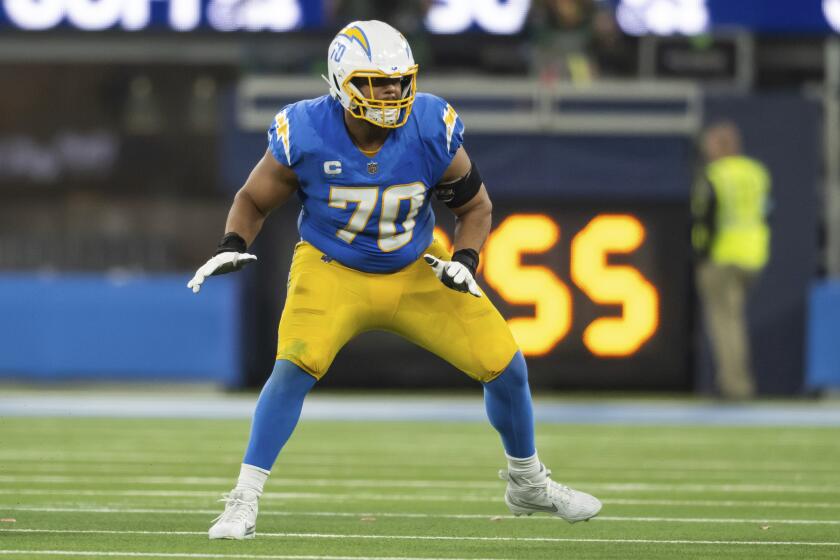The Chargers were blindsided in the truest sense.
Eleven days after signing a contract extension that made him the NFL’s highest-paid offensive lineman in history, Chargers left tackle Rashawn Slater went down in training camp with a knee injury that ended his 2025 season.
Advertisement
It was the latest crushing blow to a franchise with a withering track record of losing key players at the most inopportune times.
“It’s like a gut punch to the solar plexus,” coach Jim Harbaugh said in the aftermath of the July 27 injury. “Takes the wind out of you.”
This is where coaching and creativity kick in. It’s musical chairs along the offensive line as the Chargers scramble to protect the blind side of franchise quarterback Justin Herbert without handcuffing their offense by committing too many resources to doing so.
The challenge is profound but not unique. Teams have navigated these choppy waters before.
Advertisement
“The basis of your pass [protection] basically is, you pay a ton of money to somebody that’s just going to lock down that end, the blind side,” retired NFL quarterback Matt Hasselbeck said. “The blind side. They made a whole movie about it. That’s where you spend your money.”
When quarterback Rich Gannon was preparing for an opponent, the first offensive meeting of the week was about protections. How are we going to block these guys?
“We’d start by drawing five guys on the board, our offensive line,” Gannon said. “You’re just like, ‘OK, we’re going to build an offensive line.’ And we’d start with the left tackle, right? We’d just draw a big dollar sign. That’s the guy you have to pay. That’s the guy you have to have.”
In the case of the Chargers, erase that dollar sign from the board.
Advertisement
“When you lose a guy like that, there’s a trickle-down effect,” Gannon said. “You have to find someone to replace him. Now, what does that mean for our protection plan?
“Very few teams have a guy that can step in without a drop-off. And you’re talking about a Pro Bowl-caliber player at left tackle, there’s usually a significant difference when the backup goes in.”
Chargers quarterback Justin Herbert, left, and offensive tackle Rashawn Slater walk off the field after a win over the New Orleans Saints in October. (Ronald Martinez / Getty Images)
Even in this abysmal situation, there are flickers of positivity for the Chargers. First, they are moving Joe Alt from right tackle to left, where he spent his illustrious college career at Notre Dame. The Chargers used the fifth overall pick in 2024 on the 6-foot-8, 322-pound Alt, who Harbaugh says has Hall of Fame potential. Having Alt in the mix is a huge bonus for the club.
Advertisement
Still, switching from right to left tackle is no small feat.
“People think it’s just easy to play on the offensive line, and if you’re a right tackle you should be able to play on the left, but it’s not the same,” Hall of Fame defensive end Dwight Freeney said. “Everything is different. You have muscle memory and different repetitions that you’ve done constantly. Doing something the same way all the time. One way.
“It’s not easy to pick up, switch your feet and go to the other side. The guard positions and center are more interchangeable, but when you start messing with your tackles, especially your left tackle, that’s a problem.”
More good news for the Chargers is that swing tackle Trey Pipkins is a blocker who can play on both ends of the offensive line. He too is returning to a familiar spot, as he was a right tackle at the University of Sioux Falls.
Advertisement
The Chargers will be tested right away. Their first three games are against division opponents, and their third is against Denver, which led the NFL last season with an average of 3.6 sacks per game.
Read more: Chargers’ Ladd McConkey can finally learn from Keenan Allen in person
“You’re going to have to start the season making sure you’ve got a back over there on the left side, or a tight end in passing situations just to make sure the quarterback doesn’t get whacked,” said Mike Tice, the onetime Minnesota Vikings head coach whose specialty is coaching offensive lines. “You’ve got to have a plan going into the season. If you don’t have a plan going in, you’re truly [doomed].”
Gannon said the Chargers are especially fortunate to have Greg Roman as their offensive coordinator, because Roman showed exceptional creativity in Baltimore beefing up their front with extra linemen and fullback Patrick Ricard, nicknamed “Pancake Pat” for his ability to flatten people in his path.
Advertisement
“They dressed it up with the Ravens,” said Gannon, an analyst for Sirius/XM NFL Radio. “Seven offensive linemen on the field. You’d get the defense to go big, then throw it.”
Gannon sees the versatile Scott Matlock playing the Ricard role for the Chargers. Matlock, listed on the roster as a fullback, is 6-4 and 296.
“His role is going to expand,” the retired quarterback predicted. “That’s how you do it. That’s how you build in protection when you’re down a left tackle.”
Read more: Chargers vs. Saints takeaways: Trey Lance closing the gap in backup QB race
And though Harbaugh described the setback as a gut punch, Hasselbeck noted there’s a thread of a silver lining.
Advertisement
“From the front-office part of it, this is actually not the worst timing,” he said. “Not that there are great left tackles on the street, but at least you can do something now in training camp.
“It’s not as dire as losing your star guy on Friday before Week 1, or losing him during Week 1. Also, when guys get hurt early in the year and you lose them for the season, they’re more ready to go earlier in the offseason the next year.”
Big blocker. Small consolation.
This story originally appeared in Los Angeles Times.
